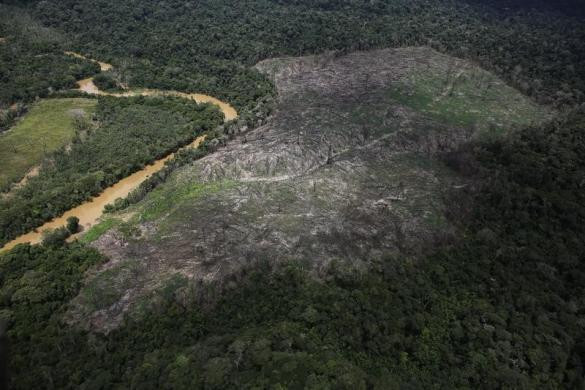Deforestation in temperate zone cuts rainfall in tropics by 18%

In yet another demonstration of the inter-connectedness of the planetary ecosystem, a study has shown that large-scale deforestation in the temperate and high latitudes can drastically affect rainfall in the distant tropics.
It causes changes in atmospheric circulation resulting in a southward shift in the monsoon rains, leading to a significant fall of 18% in precipitation in the northern hemisphere monsoon regions of East Asia, North America, North Africa and South Asia.
The deforestation also causes moderate increases in rainfall in the southern hemisphere monsoon regions of South Africa, South America and Australia.
India's rainfall will be cut by nearly a fifth, says the study done by scientists at Divecha Center for Climate Change at the Indian Institute of Science.
They used a model simulating atmosphere circulation, as well as photosynthesis, transpiration, warming of the ocean surface and ice melt.
"Our study is showing that remote deforestation in mid- and high-latitudes can have a much larger effect on tropical rainfall than local tropical deforestation," the authors say in statement issued by the institute.
Besides increasing the carbon dioxide levels in atmosphere, deforestation also causes changes in the light reflected off the earth's surface and the amount of moisture in the atmosphere from plants transpiring.
The researchers looked at three deforestation scenarios in tropical, temperate and high-latitude areas.
The study was carried out by Govindasamy Bala, N Devaraju and Angshuman Modak from the Divecha Center for Climate Change at the Indian Institute of Science, Bangalore.
"When a climate effect of deforestation is estimated, only the amount of carbon dioxide released to the atmosphere, a biogeochemical effect, and its warming potential is calculated," says Bala, one of the authors.
"The changes to surface characteristics such as reflectivity and plant transpiration (biogeophysical changes) and their effect on climate are not accounted."
The paper is published in the Proceedings of the National Academy of Sciences (PNAS).
Evaluations of the climate benefits of planting trees on bare or cultivated land or in deforested areas must include remote impacts such as rainfall.
The study noted that land used for crops and pastures has increased globally by about 7% of the global land surface in the 1700s, to over 30% or a third of the world's land surface in 2000.
Tropical deforestation
Another study had recently demonstrated how clearing of trees in tropical rainforests affects rainfall patterns and raises temperatures far way.
Much like the 'butterfly effect' in chaos theory which predicts the sensitivity of the planet's dynamics wherein the flutter of the insect's wings in Brazil can set off a storm in Texas, the University of Virginia study said that deforestation in South America, Southeast Asia and Africa can alter agriculture as far away as the US Midwest, Europe and China, besides the tropics.
Tropical deforestation has increased by 62% over the last two decades, showed a University of Maryland study using satellite images.
India has around 21% of its geographical area under forest cover, but 42% of that falls in the "open forest" category indicating poor quality. Very dense forest category accounts for only 12% of the 21% area under forest cover.
The felling of trees is banned under the Forest (Conservation) Act, 1980, but the act is being reconsidered to allow for ambitious growth prerogatives of the present government.
Compensatory afforestation is one of the options being studied though experts have pointed out that the resulting monoculture plantations do not substitute for loss of natural forests.
Nations and organisations have committed at the UN Climate Summit to cut natural deforestation in half by 2020 and end it by 2030. But the ground situation shows a different picture.
© Copyright IBTimes 2025. All rights reserved.





















